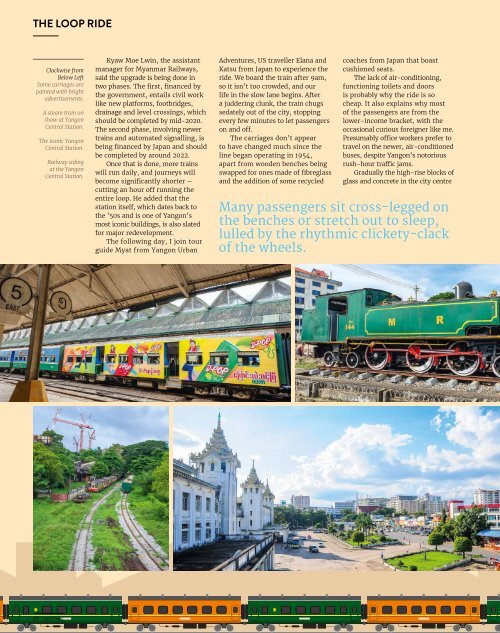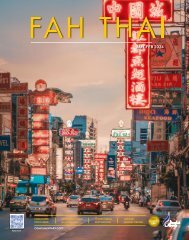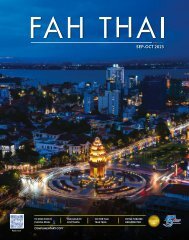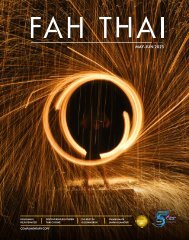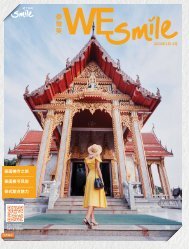Fah Thai Magazine Jan-Feb 2020
Fah Thai Magazine Issue Jan-Feb 2020, In-Flight Magazine of Bangkok Airways.
Fah Thai Magazine Issue Jan-Feb 2020, In-Flight Magazine of Bangkok Airways.
- No tags were found...
You also want an ePaper? Increase the reach of your titles
YUMPU automatically turns print PDFs into web optimized ePapers that Google loves.
THE LOOP RIDE<br />
Clockwise from<br />
Below Left<br />
Some carriages are<br />
painted with bright<br />
advertisements.<br />
A steam train on<br />
show at Yangon<br />
Central Station.<br />
The iconic Yangon<br />
Central Station.<br />
Railway siding<br />
at the Yangon<br />
Central Station.<br />
Kyaw Moe Lwin, the assistant<br />
manager for Myanmar Railways,<br />
said the upgrade is being done in<br />
two phases. The first, financed by<br />
the government, entails civil work<br />
like new platforms, footbridges,<br />
drainage and level crossings, which<br />
should be completed by mid-<strong>2020</strong>.<br />
The second phase, involving newer<br />
trains and automated signalling, is<br />
being financed by Japan and should<br />
be completed by around 2022.<br />
Once that is done, more trains<br />
will run daily, and journeys will<br />
become significantly shorter –<br />
cutting an hour off running the<br />
entire loop. He added that the<br />
station itself, which dates back to<br />
the ’50s and is one of Yangon’s<br />
most iconic buildings, is also slated<br />
for major redevelopment.<br />
The following day, I join tour<br />
guide Myat from Yangon Urban<br />
Adventures, US traveller Elana and<br />
Katsu from Japan to experience the<br />
ride. We board the train after 9am,<br />
so it isn’t too crowded, and our<br />
life in the slow lane begins. After<br />
a juddering clunk, the train chugs<br />
sedately out of the city, stopping<br />
every few minutes to let passengers<br />
on and off.<br />
The carriages don’t appear<br />
to have changed much since the<br />
line began operating in 1954,<br />
apart from wooden benches being<br />
swapped for ones made of fibreglass<br />
and the addition of some recycled<br />
coaches from Japan that boast<br />
cushioned seats.<br />
The lack of air-conditioning,<br />
functioning toilets and doors<br />
is probably why the ride is so<br />
cheap. It also explains why most<br />
of the passengers are from the<br />
lower-income bracket, with the<br />
occasional curious foreigner like me.<br />
Presumably office workers prefer to<br />
travel on the newer, air-conditioned<br />
buses, despite Yangon’s notorious<br />
rush-hour traffic jams.<br />
Gradually the high-rise blocks of<br />
glass and concrete in the city centre<br />
Many passengers sit cross-legged on<br />
the benches or stretch out to sleep,<br />
lulled by the rhythmic clickety-clack<br />
of the wheels.<br />
give way to single-storey, wooden<br />
houses in the suburbs, with the train<br />
rumbling past tea houses, noodle<br />
shops, temple decoration workshops<br />
and vegetable gardens. Farmers can<br />
be seen standing knee deep in lush<br />
fields and the rural traffic stops at<br />
manually operated level crossings or<br />
for red flags waved by railway staff.<br />
Our attention isn’t always fixed<br />
on what’s happening beyond the<br />
window, as the constantly changing<br />
cast of characters on board is just as<br />
entertaining. Many of the passengers<br />
sit cross-legged on the benches<br />
or stretch out to sleep, lulled by<br />
the rhythmic clickety-clack of the<br />
wheels. Others chat or nibble on<br />
snacks, while mothers feed their<br />
babies and teenagers thumb the<br />
screens of their mobile phones.<br />
I quickly realise that people<br />
in Myanmar love their snacks:<br />
vendors who wander through the<br />
carriages are doing a roaring trade<br />
in everything from boiled eggs,<br />
iced lollies, slices of watermelon<br />
and avocados to cakes and little<br />
betel-leaf wraps to chew on. There<br />
is even someone offering to tell<br />
people’s fortunes for 500 kyat (33<br />
US cents).<br />
Rules say peddlers are not<br />
allowed to sell their wares on<br />
the train, yet they are generally<br />
tolerated. Each seller uses a<br />
distinctive call to advertise their<br />
wares, and the betel vendors appear<br />
to be particularly popular.<br />
After about an hour and a half,<br />
the train grinds to a halt where the<br />
northern stretch of the line is being<br />
upgraded. All along the track, we<br />
can see workers digging trenches for<br />
new drainage systems, laying bricks<br />
for platforms and shovelling stones<br />
to lay new sleepers and tracks. There<br />
is not a single machine to help them,<br />
which explains why the upgrade is<br />
taking so long.<br />
We hop off the train and stroll<br />
Clockwise from<br />
Top Left<br />
Pansodan Bridge<br />
at Yangon Central<br />
Station.<br />
Myat explaining our<br />
route from Maha<br />
Bandula Park.<br />
Elana catches a breath<br />
of fresh air.<br />
Workers at Danyingon<br />
Station taking a break.<br />
A painted carriage<br />
under a new<br />
footbridge.<br />
Many carriages are in<br />
serious need of repair.<br />
62 63


